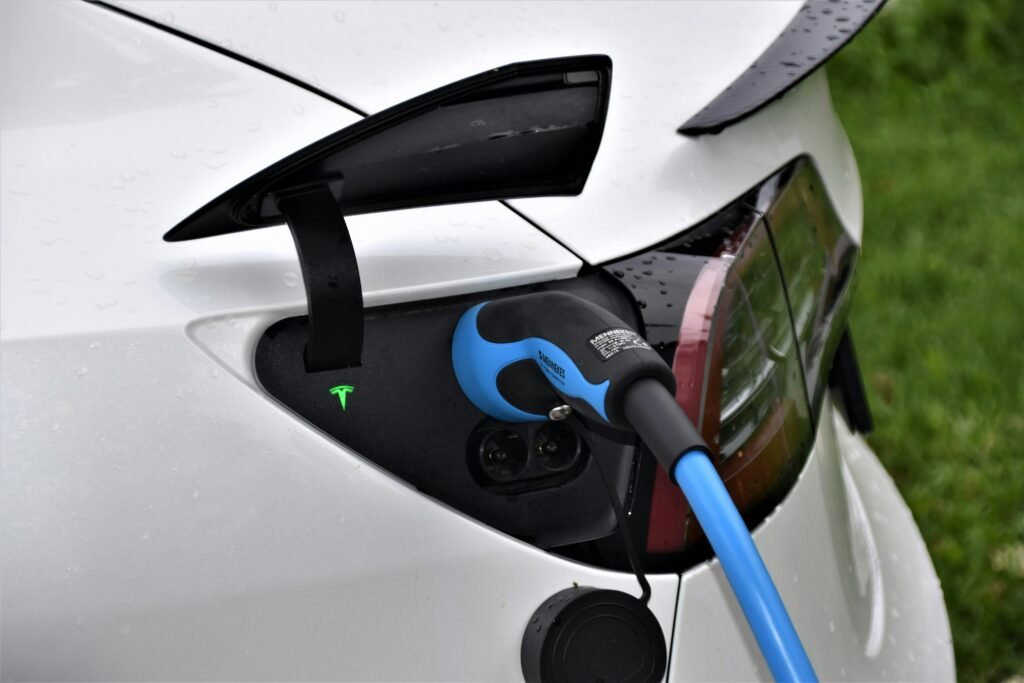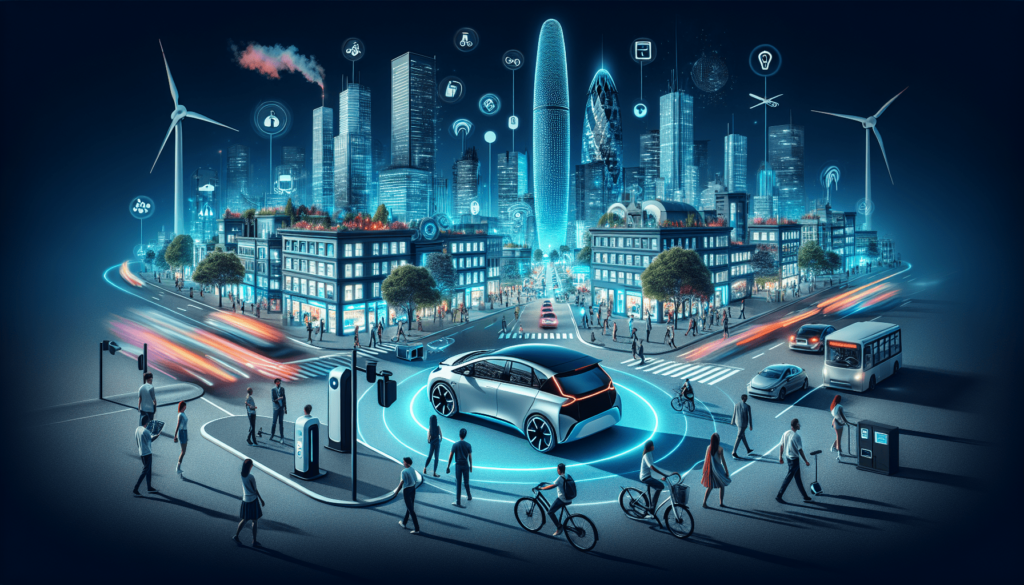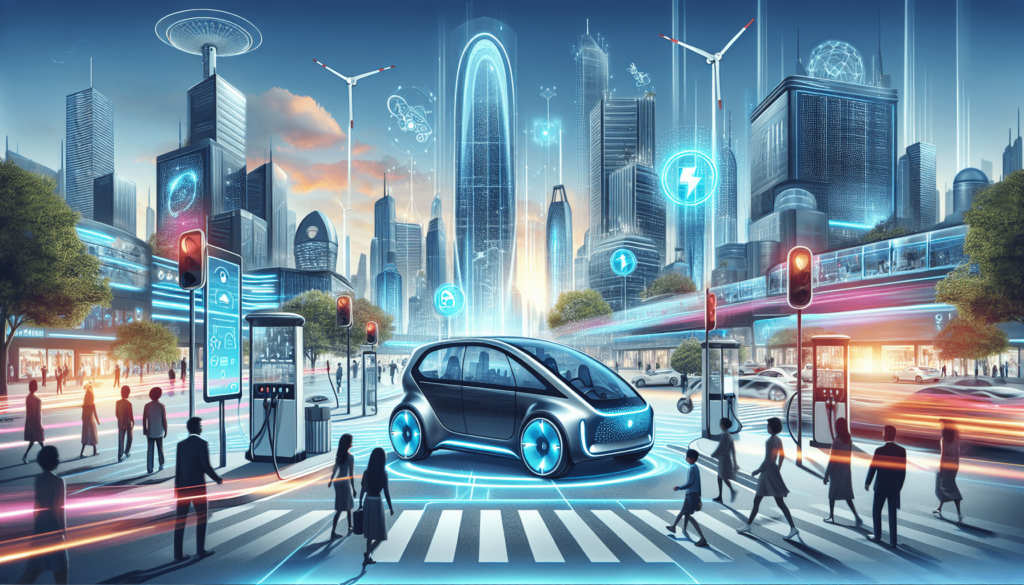Imagine strolling through a city where the air is cleaner, the streets are quieter, and every vehicle gliding by is a testament to modern technology – welcome to the future painted by smart city initiatives. At the heart of this transformation are electric vehicles (EVs), not just altering our commute but redefining our urban spaces. The role they play in this grand scheme involves more than just reducing carbon emissions; it’s about crafting an interconnected, sustainable urban ecosystem. Let’s explore how electric vehicles are crucial cogs in the machine of smart city development, making the cities of tomorrow not just greener, but smarter too.

Defining Smart Cities and Their Objectives
Overview of smart city concepts
Imagine you’re walking down the street of a city where every element, from streetlights to trash bins, is interconnected and smart. That’s the heart of a smart city. In these cities, technology isn’t just a convenience; it’s woven into the fabric of urban living to enhance the environment, economy, and personal lives of residents. Through the use of sensors, IoT devices, and big data analytics, smart cities aim to optimize city functions, drive economic growth, and improve the quality of life for everyone.
Core objectives of smart cities: sustainability, efficiency, and quality of life
At the core, smart cities strive for sustainability, efficiency, and an enhanced quality of life. Sustainability is about using resources wisely and maintaining balance with the natural environment. Efficiency involves the seamless operation of urban systems, ensuring that resources are utilized optimally with minimal waste. And quality of life? Well, that’s about making your life easier and more enjoyable, with less time stuck in traffic and more green spaces and services tailored to your needs.
The integration of technology and infrastructure in smart urban development
Smart cities integrate technology and infrastructure in a way that’s seamless. Imagine streetlights that adjust based on pedestrian movement or traffic lights that manage flow to reduce congestion, all thanks to real-time data analysis. This integration isn’t just about convenience; it’s a strategic approach to urban development that leverages technology to solve traditional urban challenges, making cities more livable, resilient, and adaptable to the needs of their residents.
Understanding Electric Vehicles (EVs)
Basic principles and types of electric vehicles
Electric Vehicles (EVs) are not just cars without a petrol tank. They represent a fundamental shift in automotive technology, powered entirely by electricity stored in batteries. There are several types, including Battery Electric Vehicles (BEVs) that rely solely on batteries, and Plug-in Hybrid Electric Vehicles (PHEVs) that combine a battery with a conventional engine. What sets them apart is their operation is cleaner and more efficient, offering a glimpse into a future of transportation that’s not tied to fossil fuels.
Benefits of EVs over conventional vehicles
Have you ever wanted to say goodbye to gas stations and oil changes? EVs make this a reality. They offer significant benefits over conventional vehicles, including lower operating costs since electricity is cheaper than gas, and fewer moving parts mean less maintenance. Plus, they’re quieter and offer smoother acceleration. But most importantly, they release zero emissions while driving, standing as a testament to their environmental benefits.
Technological advancements in EVs
The world of EVs is evolving rapidly, thanks to groundbreaking technological advancements. Batteries are becoming more efficient and cost-effective, extending the range EVs can travel on a single charge. Features like regenerative braking, which recovers energy typically lost during braking, further enhance their efficiency. And with innovations such as fast charging technology and increasingly sophisticated driver-assistance systems, the future of EVs is looking brighter by the day.
Environmental Benefits of EVs in Urban Areas
Reduction of greenhouse gas emissions
One of the crown achievements of EVs in urban areas is their ability to dramatically reduce greenhouse gas emissions. Unlike their gasoline-powered counterparts, EVs don’t spew exhaust fumes laden with carbon dioxide, a leading driver of climate change. As cities adopt more renewable energy sources to power themselves, the environmental impact of EVs will only improve, making them a cornerstone of sustainable urban living.
Improvement in urban air quality
Imagine a city where the air is noticeably cleaner, and breathing is easier—a city dominated by EVs. By eliminating tailpipe emissions, EVs play a pivotal role in improving air quality, thus contributing to healthier urban environments. This shift can lead to a decrease in respiratory diseases and create cities that are more pleasant and healthier places to live.
Noise pollution reduction
Imagine a morning where your alarm clock isn’t accompanied by the sound of roaring engines and honking cars. EVs promise to quieten the urban soundscape significantly. With their whisper-quiet operations, they contribute to a substantial reduction in noise pollution, making cities not only more livable but also places where the sounds of nature can find their way back into the urban chorus.
EVs and Energy Efficiency
Energy consumption comparison
When you compare EVs to conventional vehicles, it’s like comparing LED bulbs to incandescent ones in terms of energy efficiency. EVs convert over 60% of the electrical energy from the grid to power at the wheels, whereas conventional vehicles only manage about 20% efficiency with the energy stored in gasoline. This stark difference highlights how EVs can drive us toward a more energy-efficient future.
Renewable energy integration
Now picture charging your car the same way you water your plants – with natural resources. EVs offer a seamless integration with renewable energy sources, such as solar or wind power, enabling a transportation solution that’s not just cleaner but also renewable. As more homes and businesses install solar panels, the prospect of charging your EV with the power generated on your roof becomes a reality, further reducing the carbon footprint of personal transportation.
Smart charging and grid optimization
Smart charging turns the concept of charging an EV into something more sophisticated than just plugging it in. It involves charging during off-peak hours or when there’s surplus renewable energy, thus balancing demand on the grid and ensuring energy is used efficiently. Moreover, with vehicle-to-grid technologies, EVs can even supply energy back to the grid during peak times, playing a crucial role in grid stabilization and optimization.

Infrastructure for EVs in Smart Cities
Charging station networks and accessibility
A future where EVs are as common as smartphones hinges significantly on the availability of charging stations. Smart cities are addressing this by expanding networks of public charging stations, making them as accessible as petrol stations. This infrastructure is not just about quantity but also the quality, ensuring fast charging capabilities that make owning an EV convenient for everyone, regardless of whether they have a driveway or garage.
Integration with smart grids for energy management
Imagine a city that manages its energy like a meticulous accountant. That’s what smart grids and EV infrastructure can achieve together. This integration allows for the smart distribution of energy based on demand and availability, reducing waste and enhancing sustainability. EVs become not just consumers of energy but potential suppliers, contributing to a more resilient and flexible urban energy network.
Future prospects: Wireless charging and autonomous parking
The future of EV infrastructure in smart cities looks straight out of a sci-fi novel, featuring technologies like wireless charging, where EVs get charged by simply parking over a charging pad, and autonomous parking systems that could allow EVs to be charged without any human intervention. These innovations promise to make EVs more user-friendly and integrated into the fabric of urban living, further accelerating their adoption.
Impact of EVs on Urban Mobility
Reducing traffic congestion through efficient routing
With smart technologies, EVs can contribute to reducing the bane of urban living: traffic congestion. Through efficient routing powered by real-time data, EVs can navigate cities in the most efficient way possible, minimizing time spent in traffic and optimizing the overall flow of vehicles. This not only saves time but also reduces the energy consumption and emissions per journey.
Shared EV fleets and public transportation enhancement
Envision a city where public transportation and shared mobility solutions work hand in hand. Shared EV fleets, complementing public transit, offer flexible, eco-friendly alternatives to private car ownership. This shift can drastically reduce the number of vehicles on the road, further alleviating congestion and making urban transportation more sustainable and accessible.
Autonomous EVs and future urban transport
The advent of autonomous EVs represents a paradigm shift in urban mobility. These driverless cars promise to make transportation safer, more efficient, and more accessible, especially for those unable to drive. By reducing the need for parking spaces and streamlining traffic flow, autonomous EVs could significantly reshape the urban landscape, making cities more pedestrian-friendly and green spaces more abundant.

Policy and Regulatory Framework for EV Adoption
Government incentives and subsidies
For EVs to truly take off, a little push from the government can go a long way. That’s why many governments are offering incentives and subsidies for EV purchasers, like tax breaks or grants, making EVs more financially attractive. These policies not only encourage individuals to make the switch but also signal to manufacturers the growing demand for EVs, spurring further innovation and investment in the sector.
Regulations promoting EV manufacturing and adoption
Beyond incentives, governments are getting stricter with regulations that promote EV manufacturing and adoption. These can include mandates for carmakers to produce a certain percentage of electric vehicles, requirements for public fleets to transition to EVs, or the implementation of low-emission zones in cities. Such regulations not only accelerate the shift toward electric transportation but also push the automotive industry towards cleaner, more sustainable practices.
Global examples of successful EV policy implementation
Looking around the world, there are shining examples of how policy can drive EV adoption. Norway, for instance, has become a leader in EV adoption, thanks to comprehensive policies that include substantial tax exemptions, free toll road access, and extensive charging infrastructure. Such success stories offer valuable lessons and inspiration for other countries aiming to boost their EV uptake.
Public Perception and Adoption of EVs
Consumer awareness and attitudes towards EVs
The journey of EVs into the mainstream is not just about technology and infrastructure but also about winning over hearts and minds. Consumer awareness and attitudes play a critical role in the adoption of EVs. As understanding and familiarity with the benefits of EVs grow, so does the willingness of individuals to embrace electric mobility. Overcoming misconceptions about range, charging times, and costs is key to shifting public perception in favor of EVs.
Challenges in EV adoption
Despite the growing interest, several challenges stand in the way of widespread EV adoption. Range anxiety, the fear of running out of power without access to a charging station, is a significant hurdle. Additionally, the upfront costs of EVs, though decreasing, still pose a barrier for many. Addressing these challenges through technology advancements, infrastructure expansion, and continued education is crucial for accelerating EV adoption.
Educational campaigns and community engagement
To bridge the gap between perception and reality, educational campaigns and community engagement initiatives are vital. These efforts can demystify EV technology, showcase the long-term savings and environmental benefits, and highlight the growing support infrastructure for EVs. By engaging directly with communities, stakeholders can dispel myths, answer questions, and build a robust ecosystem of EV supporters.

Economic Impacts of EVs on Smart Cities
Job creation in the EV industry
The rise of EVs doesn’t just signify a shift in how we move; it also sparks economic transformation. As demand for EVs grows, so does the need for a skilled workforce to design, manufacture, and service these vehicles. This transition holds significant potential for job creation across various sectors, including automotive, energy, and technology, contributing to the economic vitality of smart cities.
Impact on oil demand and transportation costs
The widespread adoption of EVs could substantially reduce urban dependence on oil, decreasing the vulnerability of cities to oil price fluctuations. Moreover, with lower operating and maintenance costs, EVs offer a more cost-effective long-term alternative for individuals and businesses alike, potentially reducing overall transportation costs and contributing to economic resilience.
Long-term economic benefits of sustainable transportation
Investing in EVs and related infrastructure is more than just an environmental initiative; it’s a sound economic strategy for cities. Sustainable transportation systems, anchored by EVs, can enhance urban mobility, attract businesses, and improve the overall quality of life, laying the groundwork for long-term economic growth and prosperity. By prioritizing EVs, cities can position themselves as forward-thinking, sustainable metropolises that are attractive places to live, work, and invest.
Challenges and Future Directions
Technical and infrastructural hurdles
As promising as EVs are, the road ahead isn’t without its bumps. Addressing technical challenges such as improving battery technology, increasing charging speed, and expanding charging infrastructure are critical for the future of EVs. Overcoming these hurdles requires continued innovation, investment, and collaboration among governments, industry, and communities.
Future technologies in EVs and their role in smart cities
Looking to the horizon, the integration of future technologies like autonomous driving and vehicle-to-grid systems will further cement the role of EVs in smart cities. These advancements promise to revolutionize urban mobility, enhance energy efficiency, and further reduce the environmental impact of transportation. As these technologies mature, they will play a pivotal role in shaping the sustainable, interconnected cities of the future.
Strategies for overcoming challenges to further EV roll-out
To surmount the challenges and harness the full potential of EVs, a multipronged approach is necessary. This includes bolstering R&D efforts for advanced technologies, expanding and optimizing charging infrastructure, and forging strong public-private partnerships. Moreover, fostering public awareness and support through effective communication and engagement strategies will be crucial in driving the transition to electric mobility. Together, these efforts can pave the way for EVs to thrive in smart cities, creating a cleaner, more sustainable, and more livable urban future.

